
This Thursday, the Cleveland Landmarks Commission will address the proposed demolition of the Henry C. Holt residence. It is one of six extant houses in Cleveland designed by Charles Schweinfurth, the greatest architect in this city in the last quarter of the 19th century. When we look at it as it is today, it can be hard to imagine how it once appeared.
I've finally seen photographs of the interior. I'm not sure quite how to respond. Had this information been available earlier, things would have been easier for all involved parties. This post will help illustrate what this once great house looked like.

From Building, June, 1884. Courtesy of Special Collections, Cleveland Public Library.
This illustration provides the best record we have of what the exterior might have looked like. Most of the details are the same as those present in this 1954 photograph.
Some have suggested that the 1954 photograph represents a more accurate deption of the house as built than the 1884 illustration. I believe otherwise. This image, while of poor quality, from the Plain Dealer, May 10, 1895, part 2, page 7, shows a couple items that have changed. It includes the second floor porch, which was gone by 1954. It also shows the porch in its original format, which was expanded, probably before 1913, as evidenced by this detail from a Sanborn Fire Insurance map. The 1896 Sanborn map confirms the original shape of the front porch.
It is worth noting that, on the sides of the house visible here, all but one of the windows appear to be of the original size and in the original location. While they are replacements, it will be much easier to return the house to the proper appearance than it might have been had the size of the window openings been altered.
The rather smooth exterior lines appear to be the result of new shingles having been installed over the existing shingles at some point in the past. The removal of these shingles will likely reveal a considerable amount of the original detail, just as is often the case when aluminum or vinyl siding is removed from a historic home. Schweinfurth's Richard T. Coleman residence illustrates this clearly.
The Richard T. Coleman residence and the Henry C. Holt residence are good subjects for comparison. The Holt residence was designed by Charles and Julius Schweinfurth in 1883, and built at a cost of $5,000. The Coleman residence was built by Charles Schweinfurth in 1889, at a cost of $6,000. The Coleman residence is a bit larger than the Holt residence, so the construction cost per square foot for the Holt residence was likely higher, and with that, the finish quality as well. By comparison, the Sylvester Everett residence, an 1883 Schweinfurth commission (now demolished), cost $200,000.
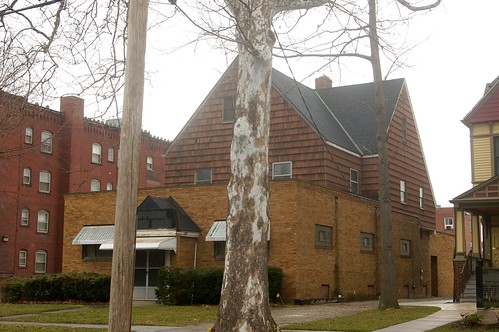
As for the other side of the house, we can reasonably assume, based on proportions, that the windows on the second and third floors are in the original locations and of the orignial proportions. Removing the brick from the first floor will reveal enough information to identify the original window openings and install proper replacements there.
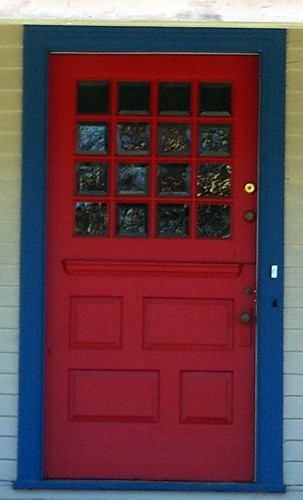
The illustration in Building shows, through the porch, the top half of the front door. It appears identical to the front door on the J.R. Owens residence, another house designed by Schweinfurth, at 1956 East 75th Street.
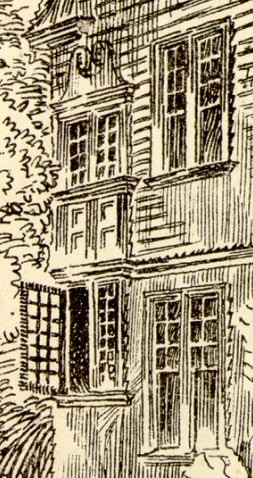
Detail. Photograph dated January 14, 1954. Courtesy of the Photograph Department, Cleveland Public Library.
Another detail worth noting is the set of classically detailed windows, to the rear of the house, which surely throw a considerable amount of natural light on the ornate woodwork that encloses the stairs.
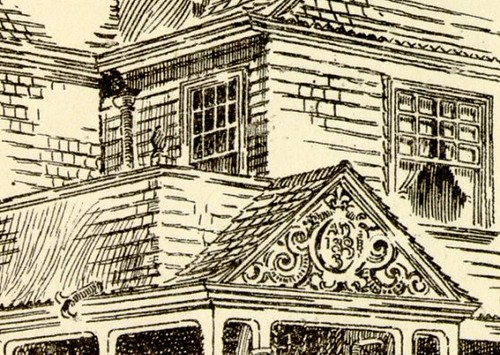
Detail. Photograph dated January 14, 1954. Courtesy of the Photograph Department, Cleveland Public Library.
This image shows a couple of interesting items. The carved detail over the porch says "A.D. 1883". There's an interesting (if possibly no longer code legal) drain outlet from the second floor porch.
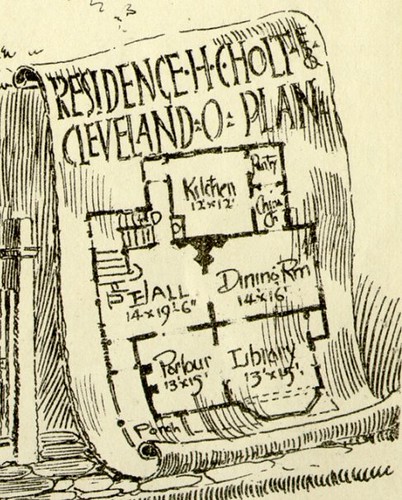
Detail. From Building, June, 1884. Courtesy of Special Collections, Cleveland Public Library.
This floorplan can help us to make some guesses as to how the interior of the house might appear. Note that there are three fireplaces on the first floor, just as in the Coleman residence.
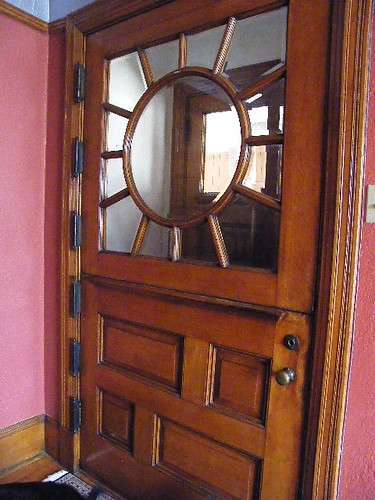
Photograph by Keri Zipay
The front door, noted above, led into a small entryway and another door. It might well be something as impressive as this one, in the Coleman residence.

Photograph by Keri Zipay
The main hall featured a grand staircase, perhaps of a style similar to the one in the Coleman residence. Alternately, it may have been similar to one that existed in Schweinfurth's own residence.
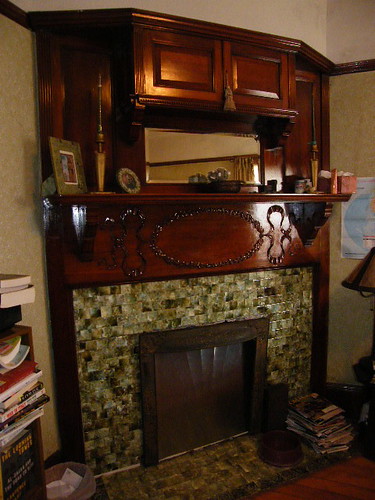
Photograph by Keri Zipay
The main hall included a fireplace situated in a corner, likely similar in finish quality to this one. From the main hall, one might have passed through pocket doors to the parlor.

Photograph by Keri Zipay
The fireplace in the parlor stuck out from the wall, like this one in the Coleman residence. From there, one might enter the library. It's difficult to know how it might have appeared. It could have been similar to the one in Schweinfurth's own residnece.
The dining room also featured a fireplace, situated in the corner.

Photograph by Keri Zipay
Between the dining room and the kitchen was a pantry. It was likely similar in design to this one, in the Coleman residence. Note that if it was being consistent with the rest of the house, the woodwork would have been unpainted.
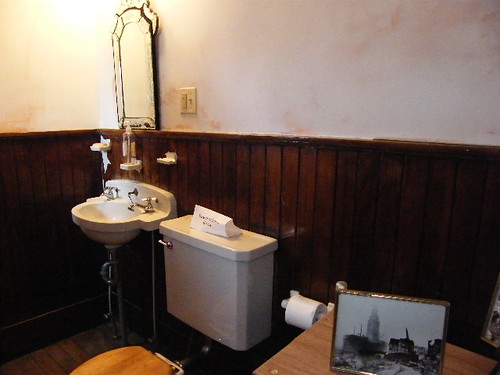
Photograph by Keri Zipay
The kitchen was likely relatively simple. It would have probably featured panelling similar to that in the Coleman residence. I use this picture of the bathroom from the Coleman residence because the kitchen in that house featured the same panelling, but in the bathroom, it remained unpainted.
The Second Floor
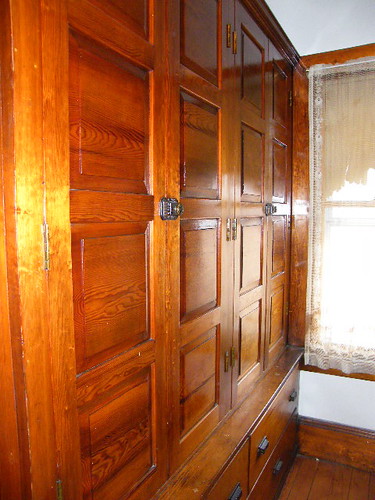
Photograph by Keri Zipay
It's hard to know the features of the second floor or how it might have been configured. One can safely assume that there may have been a couple fireplaces, as in the Coleman residence. It's also safe to assume that it featured some sort of built-in cabinetry, as shown here.
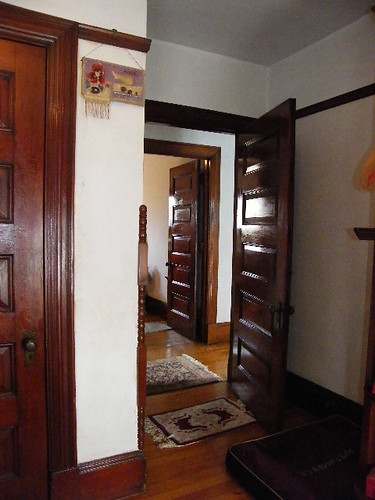
Photograph by Keri Zipay
The finish quality of the bedrooms was likely similar to that shown here, though the style could have been different. There would have been a bathroom, of course, probably similar to that on the first floor of the Coleman residence.
Some of the houses of this vintage feature a partially finished third floor, for servants. It's unclear what the state of this one was.
If you are interested in the people who lived and worked in this house and how they shaped the community, you might want to take a look at my post on that subject. It provides a broader perspective as to the significance and importance of this structure.
I don't know what to say at this point. All that made this house grand is gone. That said, a parking lot would not be a fitting tribute.
I hope that you are able to make it to the Cleveland Landmarks Commission meeting this Thursday, at Cleveland City Hall, at 9:00 am. Your presence will help the argument for the preservation of this house. If you cannot attend, consider sending an email to Landmarks Commission secretary Robert Keiser, expressing your feelings on the matter.




Thanks for another great summary of a Cleveland landmark!
ReplyDeleteHas anybody talked to Andy Fedynsky next door, who tends to Ukranian matters? He is a reasonable, intelligent man and needs to know that the demolition ought to be rethought. If you would like an introduction, please say so.
ReplyDeleteSorry to say, but this residence has been demolished.
ReplyDeleteI stop at Civilization coffee house down the street for coffee and was there this past Saturday and noticed the empty lot.
to bad that no one was able to revieaw it and save it in time. Structurally, it didn't look to be in that bad of condition, however there was in fact a lot of "deconstruction" needed from it's gig as a funeral home.
Tremont has a lot to offer. Unfortunately the only thing which seems to garner the most attention is the "Christmas Story" house.
There is a FABULOUS house right on 14TH. Which I'd like to hear about. A big white one which someone has been working on. I'll get you the address.
Keep us posted on other great sites !
Terrific web-site you have here !